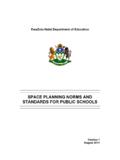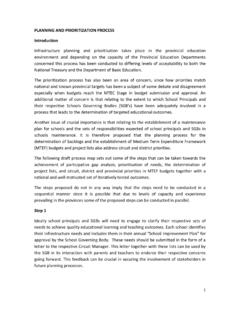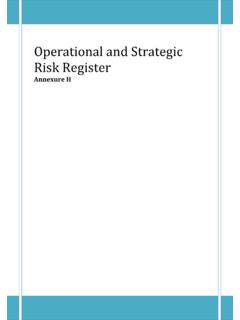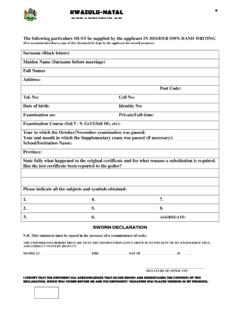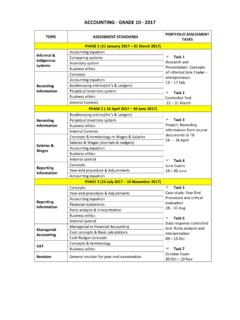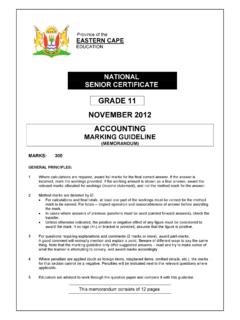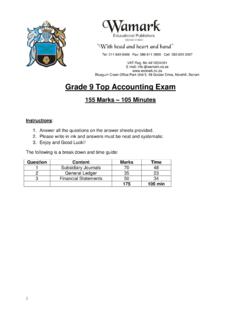Transcription of ACCOUNTING SELF STUDY GUIDE - GRADE 10 - 12
1 NATIONAL CURRICULUM STATEMENT ACCOUNTING GUIDE GRADE 11 - 12 1 TABLE OF CONTENT The purpose of this self STUDY GUIDE .. 2 How to use this document .. 2 ACCOUNTING Equation .. 3 How To Teach ACCOUNTING Equation .. 3 T-Account Basics .. 5 The effect of ACCOUNTING Equation .. 8 Transaction analysis .. 9 Activities and Solutions .. 11 Bank Reconciliation .. 15 Introduction .. 15 Steps .. 15 Activities and Solutions .. 16 Control Accounts .. 29 Introduction .. 29 Posting Rules .. 29 Activities and Solutions .. 32 Disposal Of Tangible Assets .. 45 1. Features Of Depreciation .. 45 2. Disposal Of Non-Current Assets (Tangible Assets) .. 46 Activities and Solutions .. 49 Debtors Age Analysis .. 62 How to prepare the debtors age analysis .. 62 Activities and Solutions .. 70 Age analysis of creditors .. 73 Cash Flow Statement.
2 76 Sections of Cash Flow Statement .. 76 Activity and Solution .. 79 Cash Flow Analysis .. 82 Value Added Tax (VAT) .. 85 Vat Concepts .. 85 VAT Calculation .. 86 Cash Budget Variance Analysis .. 99 Cash budget analysis .. 100 Cash Budget Analysis and decision making .. 102 Cash Budget Variances .. 103 Analysis and Interpretation of Financial 110 Financial Ratios .. 114 1. Profitability ratios .. 116 2. Liquidity .. 118 3. Efficiency ratios .. 119 Comparisons of Financial Statements .. 121 Calculations: Percentages .. 139 Understanding Percentages .. 139 Calculation of mark-up .. 148 Simple and Compound Interest Calculation .. 151 Simple Interest .. 151 Compound Interest .. 151 153 2 The purpose of this self STUDY GUIDE The purpose of this GUIDE is to assist teachers and learners in GRADE 10 - 12 to manage and provide a detailed STUDY of the ACCOUNTING processes.
3 The self - STUDY GUIDE deals with the following topics: 1. ACCOUNTING Equation and Analysis of transactions 2. Bank Reconciliation 3. Control Accounts 4. Debtors Age analysis 5. Disposal of Tangible Assets 6. Cash flow 7. Analysis of Financial Statements 8. Calculations: Percentages 9. Value Added Tax (VAT) 10. Cash Budget Analysis and Variances The information contained in this document is intended to familiarise teachers and learner with topics indicated above. The document is not intended to serve as a complete manual, but as a GUIDE to assist teachers to cope and manage the new ACCOUNTING content. The document will form part of many other strategies and resources that will assist learners to understand ACCOUNTING . How to use this document This GUIDE should be used, as a resource for teachers and learners. Teachers should refer to the GUIDE for clarity seeking issues in the subject.
4 The GUIDE should be used in conjunction with all other resources. 3 ACCOUNTING Equation How To Teach ACCOUNTING Equation ACCOUNTING Equation or Basic ACCOUNTING Model Assets = Liabilities + Owners Equity (A = L + O) 1. In teaching the ACCOUNTING Equation (A = L + O) learners should first know the following: What is an Asset What is a liability What is an expense What is an income What is owners equity Assets: Include everything a corporation owns or everything that is due to it. Liabilities: What your business owes creditors. Owner s equity: The amount of money the shareholders have invested in the business. Expense: an expense is an outflow of money to another person or group to pay for an item or service, or for a category of costs. Income: refers to consumption opportunity gained by an entity within a specified time frame, which is generally expressed in monetary terms.
5 4 The following are examples of items classified as assets: Cash Stock / Inventory Investments Accounts Receivable / Debtors Prepaid Expenses Vehicles Land Buildings Equipment, Furniture and Fixtures Intangible assets are goodwill, copyrights, trademark, patents and computer programs. The following are examples of items classified as liabilities: Bank overdraft Accounts Payable / Creditors Accrued expenses, insurance accrued. Prepaid income, rent (received) prepaid Bank loans Long-term liabilities (mortgage bonds) Debentures The following are examples of items classified as expenses: Insurance paid Rent paid Water and lights paid Discount allowed Stationary paid Petrol and oil paid Purchases Telephone paid Interest paid Income tax VAT 5 The following are examples of items classified as incomes: Rent received Discount received Sales Interest received Retained income / Net profit Owners Equity is made up of: Paid-in capital or Share capital - The original money provided by the shareholders Retained income / Net profit T-Account Basics Accounts are a summary device that record the changes that have occurred during a period.
6 O Organizational system for businesses that allow them to analyse the cumulative effects of transactions. o Each account shows the effect of all of the increases and decreases during a period. Accounts are organized via the basic ACCOUNTING equation (Assets = Liabilities + Owners Equity.) Use a separate account for each particular: o Asset o Liability o Shareholders Equity (Owners Equity) that is involved in a transaction. Each transaction will affect at least two accounts. This is reflective of the double-entry system used in ACCOUNTING , which keeps the ACCOUNTING equation in balance. Two notable characteristics of double entry systems are: Each transaction is recorded in two accounts and Each account has two sides, debit and credit. Two entries are made for each transaction: One entry as debit in one account, and The other entry as credit in another account The two entries keep the ACCOUNTING Equation balanced.
7 6 Assets = Liabilities + Owners Equity Therefore, the combined debit balance of all accounts always equals the combined credit balance of all accounts. Double entry system means that we record the dual effects of a business transaction. Therefore, each transaction affects at least two accounts. In ACCOUNTING , accounts can be represented by the letter T and referred to as T-accounts. Accountants designate: o Left side of account = Debits o Right side of account = Credits Total Debits always equal total credits Debit: An entry affecting the left side of a T-Account. Credit: An entry affecting the right side of a T-Account Visualization of the T-Account Account Title Rules for Assets on the left-hand side of the ACCOUNTING equation: o Assets have a normal debit balance.
8 * o Increases in assets are recorded on the left (debit) side. o Decreases in assets are recorded on the right (credit) side. Increases in assets are recorded on the left side (debit) of the account. Decreases in assets are recorded on the right side (credit) of the account. Credit Debit Right Side Left Side 7 Rules for Liabilities and Owners Equity on the right-hand side of the ACCOUNTING equation: o Liabilities and Owners Equity (L & OE) have a normal credit balance.* o Increases in L & OE are recorded on the right (credit) side. o Decreases in L & OE are recorded on the left (debit) side. Increases in liabilities and owners equity are recorded as a (credit). Decreases in liabilities and owners equity are recorded as a (debit). Rules of Debit and Credit Summarized: Assets Assets = Liabilities Liabilities + Owners Equity Owners Equity Debit + Credit - Debit - Credit + Debit - Credit + That is: Assets have Dr balance as positive (+) balances Liabilities have Cr balances as positive (+) balances Owners Equity has Cr balances as positive (+) balances ACCOUNTING Equation: Assets =Liabilities+Owners Equity Rules of Debit and Credit: Debit + Debit Debit Credit Credit+ Credit+ 8 The effect of ACCOUNTING Equation 1 When an asset is brought into the business (Dr), it affects the assets positively (+ or increases the number of assets) and when it is reduced or removed from the business it affects the Assets Account negatively (Cr)(-).
9 2 When a Liability is brought into the business (Cr), it affects the Liabilities positively (+ or increases the number of Liabilities) and when it is reduced or removed it affects the Liabilities negatively (Dr)(-). 3 Owners Equity is affected by drawings (taking cash or goods for personal use) negatively (-) because money or goods are withdrawn for personal. Incomes and expenses also affect Owners equity. Incomes and additional investment into the business increase owners equity (+) (Cr) and losses/expenses and drawings decreases owners equity (-) (Dr). The following types of accounts: (1) have a normal balance as a debit or credit and (2) increase with a debit or credit. Normal Balance Assets Liabilities Expenses Revenues Dividends Retained Earnings Common Shares (DEBIT) (CREDIT) Remember: Debit Expenses Assets Dividends (DEAD) All other accounts = Credit Rules of debit and credit for Shareholders Equity are slightly different, since shareholders equity is affected by different types of accounts.
10 Common Shares Retained Earnings Dividends - + - + + - Debit Credit Debit Credit Debit Credit Expenses Revenues + - - + Debit Credit Debit Credit Summary Read the transaction and understand. Establish two account affected (double entry). 9 Establish whether those accounts are Assets, Liabilities, expenses/loss or incomes. Establish which account is debited and which one is credited. Establish the effect of the two accounts on the ACCOUNTING equation. Remember that if you keep your ACCOUNTING Equation equal, your books will balance. Transaction analysis Example of lesson Activity 1. Understanding this part of ACCOUNTING is critical.



